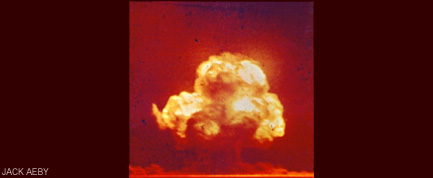How Is Radiation Exposure Measured?

About 150 people living or working around Japan's damaged nuclear facilities have been monitored for potential radiation exposure, and 23 have been found to be in need of treatment. How is the extent of their exposure measured?
According to the United States Nuclear Regulatory Commission (NRC), "exposure" refers to the amount of radiation, such as X-rays, gamma rays, neutrons, alpha and beta particles, present in the air. Exposure, usually expressed in units of roentgens, is measured by Geiger counters and similar devices. A Geiger counter registers how much the gas it contains gets ionized by incoming particles of radiation, and converts that information into an electronic signal.
People don't absorb all the radiation they're exposed to, however; most of it passes straight through their bodies. A small amount of the energy carried by radiation gets absorbed by bodily tissues, and that absorbed amount is measured in units of "radiation absorbed dose" (rad). Radiation affects different people in different ways, but a rule of thumb used by safety crews is that a single roentgen of gamma- or x-ray exposure typically produces an absorbed dose of approximately 1 rad. By measuring the radiation level around a person's body using a Geiger counter, a safety officer can approximate that person's absorbed dose.
A more sophisticated measure of radiation exposure, called the effective dose, accounts for the harmfulness of the specific type of radiation present. While the effective and absorbed doses are the same for beta and gamma radiation, for alpha and neutron radiation – types that are especially dangerous for the human body – the effective dose has a larger value than the absorbed dose. A measure of the effective dose therefore gives a concrete scale for determining how dangerous an incident of exposure actually is. Units of effective dose are the "roentgen equivalent man" (rem) and the sievert (Sv), where one Sv equals 100 rem.
An average person receives an effective dose of 0.36 rem every year, 80 percent of which comes from natural sources of radiation, such as radioactive materials in the Earth's crust and mantle and sources in outer space. The remaining 20 percent of an average person's effective dose results from exposure to artificial radiation sources, such as X-ray machines, industrial smoke detectors, and continuing fallout from nuclear weapons tests.
In the United States, the NRC limits occupational radiation exposure to adults working with radioactive material to 5 rem per year. The limit can be raised to 25 rem when there's an emergency; that level is still not considered dangerous.
Radiation levels at Fukushima shot up to 0.8 rem per hour after an explosion at one of the nuclear reactors earlier today (March 15). If emergency workers had not been evacuated shortly afterward, they would have gotten their yearly occupational dosage in just over 6 hours.
Get the world’s most fascinating discoveries delivered straight to your inbox.
Though potentially dangerous, that amount still would not have been lethal. According to the NRC, "[It] is generally believed that humans exposed to about 500 rem of radiation all at once will likely die without medical treatment. Similarly, a single dose of 100 rem may cause a person to experience nausea or skin reddening (although recovery is likely), and about 25 rem can cause temporary sterility in men. However, if these doses are spread out over time, instead of being delivered all at once, their effects tend to be less severe."
- Q&A: Nuclear Power Expert Explains Japan's Crisis
- Infographic: What Is a Nuclear Meltdown?
- What Everyday Things Around You Are Radioactive?
This article was provided by Life's Little Mysteries, a sister site to LiveScience. Follow Natalie Wolchover on Twitter @nattyover
Natalie Wolchover was a staff writer for Live Science from 2010 to 2012 and is currently a senior physics writer and editor for Quanta Magazine. She holds a bachelor's degree in physics from Tufts University and has studied physics at the University of California, Berkeley. Along with the staff of Quanta, Wolchover won the 2022 Pulitzer Prize for explanatory writing for her work on the building of the James Webb Space Telescope. Her work has also appeared in the The Best American Science and Nature Writing and The Best Writing on Mathematics, Nature, The New Yorker and Popular Science. She was the 2016 winner of the Evert Clark/Seth Payne Award, an annual prize for young science journalists, as well as the winner of the 2017 Science Communication Award for the American Institute of Physics.



